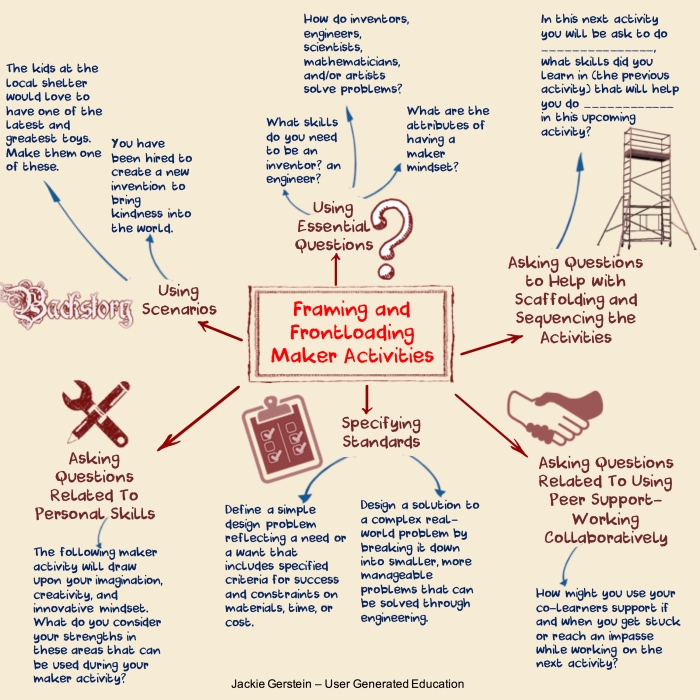Framing and Frontloading Maker Activities
As I’ve mentioned in some other posts, I come from a background in Experiential Education (yes, it is a specific professional discipline). I’ve also discussed reflecting on the learning activities to increase the chances of extracting learning as well as transferable skills and knowledge from the activities. This is an integral part of experiential education – see my previous posts, Where is reflection in the learning process? and The Maker as a Reflective Practitioner.
Another concept common to Experiential Education, that also increases the chances that transferable skills and knowledge result, is framing or frontloading the activities as part of introducing them.
Frontloading is making clear the purpose of an activity prior to actually doing it. The idea is that if participants clearly understand the purpose or lesson upfront, that lesson will repeatedly show itself during the action component. (http://chiji.com/processing.htm)
The practitioner tells or guides participants before the experience on how what they want them to focus on in the activity. It is about guided attention before the activity. (http://www.aee.org/tapg-best-p-matching-facilitation-strategy)
What are the benefits of frontloading?
- It helps participants use the upcoming activity to build on prior knowledge and experience
- It helps participants set purpose and intention for the activity
- It distributes expertise to the participants before the activity begins, as opposed to the facilitator or instructor being the only expert (http://experience.jumpfoundation.org/what-is-frontloading/)
Some of the general themes and ideas for frontloading making activities include:
- Using and Reviewing Essential Questions – explicitly discussed prior to the maker activities. For example –
- What are the attributes of having a maker mindset?
- What skills do you need to be an inventor? an engineer?
- What are the steps to the design process?
- How do inventors, engineers, scientists, mathematicians, and/or artists solve problems? How do they overcome challenges?
- Using Scenarios – for example –
- You have been hired to create a new invention to bring kindness into the world. This invention will be shared with all of the kids in the United States.
- The kids at the local shelter would love to have one of the latest and greatest of toys. Make them one of these.
- Specifying Standards – the Next Generation Science Standards include some good examples. The educator can introduce the standards and explain what they mean in terms of the upcoming maker activities. For example:
- Define a simple design problem reflecting a need or a want that includes specified criteria for success and constraints on materials, time, or cost.
- Design a solution to a complex real-world problem by breaking it down into smaller, more manageable problems that can be solved through engineering.
- Asking Questions Related To Personal Skills – for example –
- The following maker activity will draw upon your imagination, creativity, and innovative mindset. What do you consider your strengths in this area that can be used during your maker activity?
- Asking Questions to Help with Scaffolding and Sequencing the Activities – the facilitator can review previous activities and then ask participants prior to the next learning activity –
- In this next activity you will be asked to do _______________, what skills did you learn in the (previous activity) that will help you do ____________ in this upcoming activity?
- Asking Questions Related To Using Peer Support-Working Collaboratively – for example –
- How might you use your co-learners support if and when you get stuck or reach an impasse while working on the next activity?


Frontloading prepared the learner for learning. Yes.
journalplace
March 16, 2016 at 9:55 am
Great article Jackie. Really like your definition of front loading. Unfortunately, to many, it means inflicting the “theory” on young folk and then doing an activity, particularly in science. Let’s hope a lot of people read this.
MV Education Services
March 28, 2016 at 7:52 am
Thanks – frontloading should be an interactive process with the students. Teachers need to get away from talking at students.
Jackie Gerstein, Ed.D.
March 29, 2016 at 1:59 pm
Thank you Jackie. We agree this is a key concept, and often missed in teacher/instructor/facilitator training
bluepeteraustralia
October 13, 2016 at 7:44 am
I thought this was really interesting for the exceptional learner. The traditional ways of teaching does not challenge or engage all students. In the exceptional learner program students are engaged and help create their own curriculum and have a mentor to help guide them in their learning process. Would definitely help students on the right road to develop their full potential and get them thinking and establishing their own thoughts in the learning process vs. memorize and spit it out for the test.
Nancy Darst
March 29, 2016 at 2:49 am
Thanks, Nancy.
Jackie Gerstein, Ed.D.
March 29, 2016 at 1:58 pm
I LOVE this article – thanks for creating this. I come from a constructivist/science teaching background and often get asked about ways to ways we can introduce teachers into the maker mindset. For me, allowing exploration, asking questions along the way, and supporting student passions, just is ingrained in me as an educator. This blog includes all of the components of teacher & makerspaces that I’ve been rolling around in my brain for a few months – thanks for putting it in one place!
I will be leading a group of teachers through the maker movement and I plan to share this with them as elements of the teacher role in a makerspace. I definitely don’t want teachers to think that they lead students into a makerspace and sit in the corner. Teachers are a part of the maker process, they just need to realize how to release control to their students to allow this to be student-centered – who should always be at the center!
Amber Bridge
April 7, 2016 at 4:55 pm